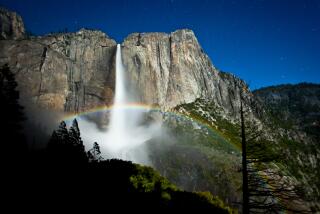Sandstone and Rainbows at Utah’s Capitol Reef
- Share via
Long ago, the Navajo called the colorful rock layers of southeastern Utah “sleeping rainbows.” Today these rock rainbows are on display in Capitol Reef National Park, which offers a remoteness and a tranquillity not found at Utah’s other major national parks.
The sleeping rainbows were formed some 70 million years ago when a dozen rock formations were uplifted and folded into what is today’s central park feature--the Waterpocket Fold, named for the pools of water trapped by the topsy-turvy strata. Wind and water erosion have since sculpted the colorful formations. The most spectacular section of the Fold, which extends 100 miles southeast from Thousand Lake Mountain to Lake Powell, is preserved within the national park.
Some of the Navajo sandstone hereabouts has eroded into the shape of domes. The rounded domes reminded explorers of the Capitol dome in Washington, D.C., hence the name Capitol Reef National Park.
The “Reef” in the park’s name also came from early explorers, who found the rock formations of the Waterpocket Fold to be an awesome and treacherous barrier to travel. They likened it to a reef blocking passage of ships at sea.
Capitol Reef was one of the last places in the continental United States to be explored or settled. Its wonders were set aside as a national monument in 1937, then the area was upgraded to national park status in 1971.
In addition to the magnificent red-rock country and some great hikes, visitors are attracted by the pre-Columbian Indian petroglyphs on the canyon walls and in nearby Fruita, an early Mormon settlement. In the midst of the park’s towering rock formations is an orchard where fruit may be picked in season.
The national park has trails for hikers of all abilities. Getting to Capitol Reef trail heads is easy; many of the most interesting sights are found in a small area. No really long drives are required, though if you choose, a 70-mile unpaved road leads down the east side of the Reef and takes experienced hikers to remote parts of the park.
Not much snow falls on the park, which is open year-round. Expect cool winter days with highs in the 40s and lows in the 20s.
Directions to trail head: The entrance to Capitol Reef National Park is five miles east of Torrey on Utah 24. The park visitor center is six miles from the entrance.
The hike: Hickman Bridge Trail, perhaps the most scenic trail in the park, begins at a signed trail head two miles east of the visitor center on the north side of 24.
At first, the path follows the cottonwood-lined bank of the Fremont River. After a short ascent, you’ll reach a signed junction, where the right-forking Rim Overlook Trail heads north to a dramatic vista point.
Continue on Hickman Bridge Trail, which climbs over some slickrock then follows a dry wash sprinkled with juniper and pinyon pine. At trail’s end is the park’s premier rock span--130-foot-long Hickman Bridge. You can walk under the sandstone bridge--named for Joseph Hickman, a local high-school principal and early park promoter--and gain good views of nearby Capitol Dome. The bridge is a favorite of photographers, who gather in the late afternoon to capture the colorful rock formations.
Experienced hikers who want a good workout will extend their excursion four miles by returning to the junction with Rim Overlook Trail. Join this path on a climb to a grand viewpoint, high on the sheer cliffs overlooking the town of Fruita and the vastness of the Waterpocket Fold. The trail crosses lots of slickrock, so the hiker must follow cairns (rock piles) en route.
Grand Wash Trail begins 4 3/4 miles east of the visitor center on the right side of 24. You can make this a one-way hike by arranging to be picked up or dropped off at the Cassidy Arch trail head, 3 1/2 miles from the visitor center on the park’s scenic drive.
Follow a dry river bed through Grand Wash, which is deep, narrow and has few exits. It’s the last place you want to be if rain threatens. Sandstone walls tower 600 to 800 feet above you. At one point the canyon narrows to only 20 feet.
Southeast Utah Hickman Bridge, Rim Overlook and Grand Wash Trails
Where: Capital Reef National Park.
Distance: To Hickman Bridge, 2 miles round trip; to Rim Overlook, 4 miles round trip; along Grand Wash Trail, 2 1/4 miles one way.
Highlights: Sculptured rock layers in a rainbow of colors, and a peacefulness not found in the more-visited national parks.
Degree of Difficulty: Easy to moderate.
For more information: Contact the Superintendent, Capital Reef National Park, Torrey, Utah 84775. (801) 425-3791.
More to Read
Sign up for The Wild
We’ll help you find the best places to hike, bike and run, as well as the perfect silent spots for meditation and yoga.
You may occasionally receive promotional content from the Los Angeles Times.






